


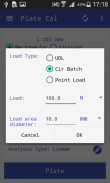
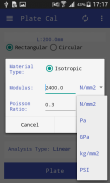
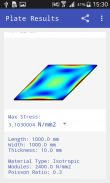
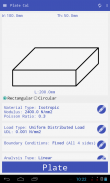
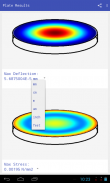
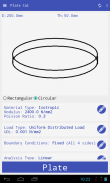
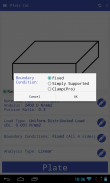
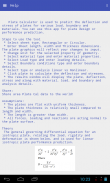
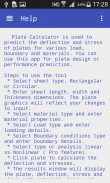
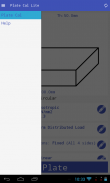

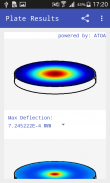
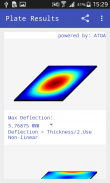
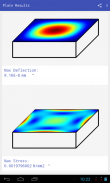
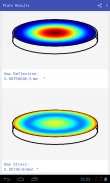
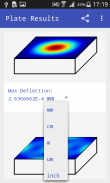
Plate Calculator Lite

وصف لـPlate Calculator Lite
This tool lets you to predict the deflection and stress of plates. The deflection and stress levels predictions are required for plate design for a given shape, load, boundary and materials. Use Plate Calculator to design of plates for any uniform pressure, local pressure or point loading.
Plates are common structural elements used in many engineering applications. For example, Roof, window, wall, door, glazing, membranes, table top, in building and construction, transportation (automobile, railway, aerospace), consumer product. These tools can be applied to MEMS systems also, as long as continuum mechanics is valid at these length scales.
Steps to use the tool
Start the program by tapping the dimension or edit icons.
1. Enter Sheet length, width and Thickness dimensions and shape Rectangular or Circular. The plate graphics will reflect your changes to input.
2. Select material type and enter material properties.
3. Select Load type and enter loading details.
4. Select Boundary conditions type and enter boundary details.
5. Select type or analysis linear vs Nonlinear ( Pro feature)
6. Click plate to calculate the deflection and stresses.
7. The results window will display the plate, deflection, stress and along with material, load, and boundary and analysis details.
Share:
Share area Plate Cal data to the world!
Assumptions:
1. The plates are flat with uniform thickness.
2. The plate thickness is relatively small compared to length and width
3. The length is greater than width
4. All forces, loading and reactions are acting normal to the plate surface.
Theory of Plates:
The general governing differential equation for an isotropic plate, relating the load, rigidity and deformation is used for linear isotropic plate performance prediction.
Isotropic plate differential equation including the effect of lateral loads and forces in the middle plane of the plate used for geometrical nonlinear performance prediction.
Similarly, orthotropic plate governing equation is also considered for orthotropic plate performance prediction.
Analytical solution for the above type of plate governing equations was compiled for various type of plate, boundary, loading conditions and is used for the plate performance prediction. Contour plot results are also provided The results predicted by Plate Calculator are also compared with numerical simulations. The analytical results predicted by app matches closely with the industry standard numerical finite element analysis solver results.
For additional support or help
Visit: http://apps.atoa.com/atoa-apps/Plate_Calculator_lite
mail: PlateLite@apps.atoa.com
























